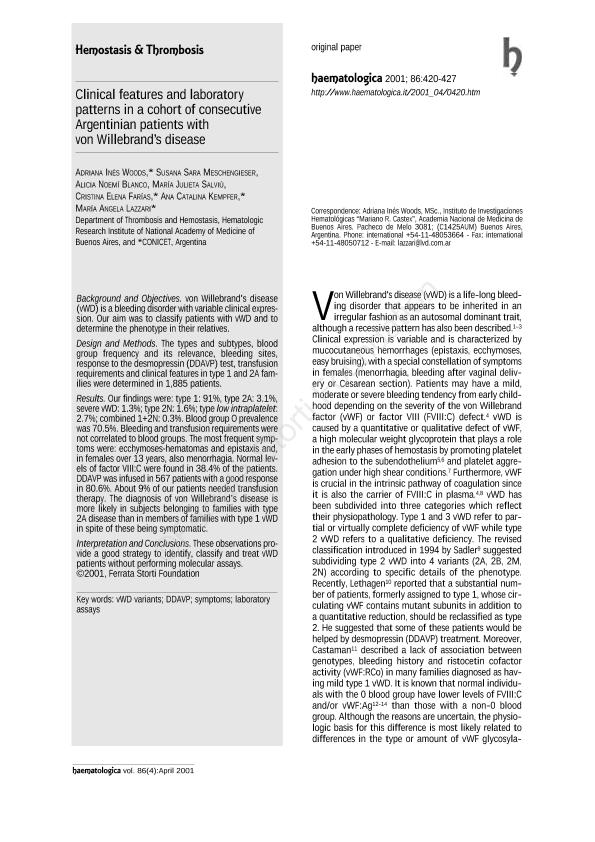Artículo
Clinical Features And Laboratory Patterns In A Cohort Of Consecutive Argentinian Patients With Von Willebrand's Disease
Woods, Adriana Inés ; Meschengieser, S. S.; Blanco, A. N.; Salviu, M. J.; Farias, Cristina Elena
; Meschengieser, S. S.; Blanco, A. N.; Salviu, M. J.; Farias, Cristina Elena ; Kempfer, Ana Catalina
; Kempfer, Ana Catalina ; Lazzari, María Ángela
; Lazzari, María Ángela
 ; Meschengieser, S. S.; Blanco, A. N.; Salviu, M. J.; Farias, Cristina Elena
; Meschengieser, S. S.; Blanco, A. N.; Salviu, M. J.; Farias, Cristina Elena ; Kempfer, Ana Catalina
; Kempfer, Ana Catalina ; Lazzari, María Ángela
; Lazzari, María Ángela
Fecha de publicación:
04/2001
Editorial:
Ferrata Storti Foundation
Revista:
Haematologica
ISSN:
0390-6078
e-ISSN:
1592-8721
Idioma:
Inglés
Tipo de recurso:
Artículo publicado
Clasificación temática:
Resumen
Background and Objectives. von Willebrand's disease (vWD) is a bleeding disorder with variable clinical expression. Our aim was to classify patients with vWD and to determine the phenotype in their relatives. Design and Methods. The types and subtypes, blood group frequency and its relevance, bleeding sites, response to the desmopressin (DDAVP) test, transfusion requirements and clinical features in type 1 and 2A families were determined in 1,885 patients. Results. Our findings were: type 1: 91%, type 2A: 3.1%, severe vWD: 1.3%; type 2N: 1.6%; type low intraplatelet: 2.7%; combined 1+2N: 0.3%. Blood group O prevalence was 70.5%. Bleeding and transfusion requirements were not correlated to blood groups. The most frequent symptoms were: ecchymoses-hematomas and epistaxis and, in females over 13 years, also menorrhagia. Normal levels of factor VIII:C were found in 38.4% of the patients. DDAVP was infused in 567 patients with a good response in 80.6%. About 9% of our patients needed transfusion therapy. The diagnosis of von Willebrand’s disease is more likely in subjects belonging to families with type 2A disease than in members of families with type 1 vWD in spite of these being symptomatic. Interpretation and Conclusions. These observations provide a good strategy to identify, classify and treat vWD patients without performing molecular assays.
Palabras clave:
Vwd Variants;
,
Ddavp
,
Symptoms
,
Laboratory Assay
Archivos asociados
Licencia
Identificadores
Colecciones
Articulos(IMEX)
Articulos de INST.DE MEDICINA EXPERIMENTAL
Articulos de INST.DE MEDICINA EXPERIMENTAL
Citación
Woods, Adriana Inés; Meschengieser, S. S.; Blanco, A. N.; Salviu, M. J.; Farias, Cristina Elena; et al.; Clinical Features And Laboratory Patterns In A Cohort Of Consecutive Argentinian Patients With Von Willebrand's Disease; Ferrata Storti Foundation; Haematologica; 86; 4-2001; 420-427
Compartir



